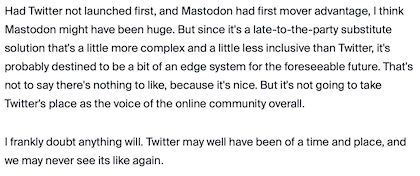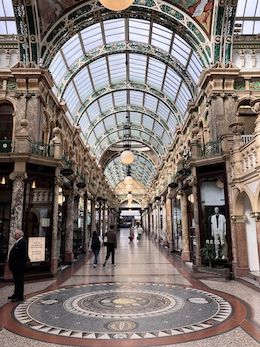At the end of August 2024 I set a hare running which has just reached its destination. A brand new piece of music now exists, because I commissioned it. The process of commissioning was surprisingly straightforward.
I have written before about the big part that singing in choirs has played in my life – symphonic choirs, chamber choirs, church choirs. A few years ago one of my sisters, A, started singing in a choir too. She joined a community choir and then more recently joined her local church choir in Penzance. I enjoyed hearing about her experiences, and talking to her about singing church music. I remembered that it can be difficult when you first start and she found the same, so I sympathised but told her it will get easier. A is just two years older than me, so of all my siblings she is the closest to me in age and we had many shared experiences from our early years. Now we have a new shared experience.
Commissions
An anthem is a short piece of devotional music performed in church. Sometimes they are called motets, if the words are Latin rather than English. Anthems are sometimes commissioned for particular occasions or places. I’ve often noticed the dedications on anthems giving the details of why they were commissioned.
One famous commissioner was Walter Hussey, a clergyman and lover of the arts. He was vicar of St Matthew’s church, Northampton for 18 years and then Dean of Chichester Cathedral for a further 22 years. In both places he commissioned many pieces of music. The anthem Rejoice in the Lamb by Benjamin Britten was written for the 50th anniversary of St Matthew’s church. Hussey also commissioned Lo, the full, final sacrifice from Gerald Finzi (1946). At Chichester Hussey’s most well-known commissions were Leonard Bernstein’s Chichester Psalms and the 1975 Chichester Service by William Walton.
Benjamin Britten wrote many commissions – his Antiphon was written for the 30th anniversary of St Michael’s Tenbury and his Wedding Anthem was composed for the marriage of the Earl of Harewood and Marion Stein.
William Matthias’ anthem Let the people praise thee, O God was composed for an even grander wedding – that of (then) Prince Charles and Diana Spencer. The choirmaster of a choir I once sang in wrote an anthem for two members of the choir who got married, a setting of O Perfect Love. We sang it at their wedding.
A golden wedding
When I realised last year that my sister A’s golden wedding anniversary was coming up in 2025, an idea started hatching in my head. I subtly enquired whether she was planning to have some sort of party. They had thrown a party for their ruby anniversary, and for their thirtieth anniversary they’d made a renewal of vows in their church in Penzance. My sister said that they were indeed planning a party.
I mulled over the idea of commissioning of an anthem to mark their golden wedding, like those I’d observed. I contacted the choir director at my sister’s church, and ran the idea past him. He was positive about the idea, though was concerned that the new piece should be appropriate to the choral forces available.
Composer’s Edition
I knew nothing about commissioning music, so I wasn’t sure where to start. In March 2024 I had attended a Making Music webinar on sourcing music and I remember hearing Dan Goren talk about Composers’ Edition (CE), a contemporary music publisher that he founded. Among other things Dan said that CE aimed to make it easy for choirs and orchestras to commission new music, so I looked further at them. I put an enquiry into their website describing my plans and soon after that Dan himself called me to discuss the potential commission. He explained the process and asked a few questions about what I wanted. Dan said he would send details of my proposed commission to all the composers on the CE list, to solicit ‘bids’ from them.
I was excited about the idea and put out a post on Bluesky:
Just had a call with someone from Composers' Edition, about my plan to commission a short choral anthem to celebrate my sister's golden wedding. This is a new thing for me – looking forward to the next step, when I will hear from some composers.
— Frank Norman (@franknorman.bsky.social) 2024-09-04T09:24:32.800Z
A few weeks later I had responses from eight composers, with varying backgrounds. I considered all of them, looking at the composers’ experience of choral and church music in particular, and listening to recordings of some of their music via the CE website. It was a bit like sifting through job applicants. Some of the composers addressed the points I’d made in my proposal, some ignored my proposal and just wrote about the music they would like to create.
After much cogitation I settled on Liz Lane. She has written church music previously and has a style that is very approachable. We had some email correspondence and then a Zoom call, during which I was able to fill in a bit more background about myself and A and the reason for the commission.
Realism
I had heard my sister’s Penzance church choir sing a few years earlier and they seemed very competent, singing a wide range of music. However lockdown had a negative impact on many choirs, and this one has shrunk in size to between 6 and 9 singers.
My own regular church choir has shrunk too and now typically has between 6 and 12 members on a Sunday morning so I’m very familiar with the challenges. We make regular use of OUP’s Easy and Flexible Anthems collection and the Novello Short Anthems collection. I think many church choirs will be in a similar position.
When talking to Liz Lane I mentioned the need for flexibility, referring to the examples of collections like these two. While a large-scale anthem for many singers would have been lovely, I wanted my commission to be performable by more meagre forces – a modest number of voices plus keyboard accompaniment.
I also passed on to Liz the comments that the Penzance choir’s director had made about the need for the new piece to be readily singable, not excessively discordant, and straightforward to learn.
I put some more Bluesky posts out.
I've had some proposals through & have chosen a composer. We had a good chat over Zoom yesterday and made good progress. I think she will do a great job. She asked whether the church choir has any instruments other than organ available. I said no, but now I wish I'd said 'onde martenot and tamtam'.
— Frank Norman (@franknorman.bsky.social) 2024-10-08T09:24:10.072Z
(This morning I've been listening to Messiaen's Trois Petites Liturgies, but you probably guessed that!).
— Frank Norman (@franknorman.bsky.social) 2024-10-08T09:25:08.508Z
Text
The next challenge was to choose a text to be set. I wanted it to be clearly suitable for religious use, but not overly ‘holy’ if you know what I mean. It should be a celebration of enduring human love. Consulting with friends who knew much about liturgical music they advised that I could consider choosing a poem, or a Biblical text. I liked the famous words from 1 Corinthians 13, and also the words of the hymn ‘O Perfect Love’ seemed appropriate. I looked at a few psalms, but they didn’t seem to fit the bill.
Liz told me that she had previously set texts by the poet Jennifer Henderson. Jennifer kindly drafted an original poem for consideration, called Joyful Promise. I liked it, but again it didn’t feel right for the anthem I had in mind. Eventually we settled on the Corinthians text and I chose some of the lines that I wanted to be included, leaving it to Liz whether she included additional lines. This is the final text that Liz set:
Love is patient, love is kind. It does not envy, it does not boast, it is not proud.
It does not dishonour others, it is not self-seeking, it is not easily angered, it keeps no record of wrongs.
Love does not delight in evil but rejoices with the truth. Love never fails.
It always protects, always trusts, always hopes, always perseveres.
And now these three remain: faith, hope and love. But the greatest of these is love
Confirmation and composition
In late November Composers’ Edition drafted a contract and Liz and I both signed it, so we were legally committed to the project. I paid Liz the first instalment of the commissioning fee. CE kept in touch periodically, checking that things were proceeding OK.
My sister already knew that I had been in touch with her church choir’s director, but she didn’t know the reason. Now that everything was confirmed I told her what was going on, resolving the mystery. I think she liked the idea of the commission.
As luck would have it I visited Bristol in December and was able to meet up with Liz as she teaches at UWE and lives in the area. We met over a cup of coffee at St George’s Brandon Hill and had a good chat.
In late January Liz sent a draft score of the new piece. I sang through it and found it very tuneful. I don’t have the ability to imagine how the whole score sounds just by looking at it, so I couldn’t judge what the complete effect would be but it looked good.
I sent the draft score to my sister’s church choir director for him to review. He and Liz had some conversations about a few points. Soon the final version was agreed and everyone was happy with it.
Production and performance
Liz sent me a selection of possible cover images and I chose one. We agreed on the precise wording that would appear on the score, to describe the commissioning and the occasion. Jennifer also kindly agreed to allow her poem to be printed in the score booklet.

Cover of the new anthem, The Gift of Love, by Liz Lane
The anthem was printed by Composers Edition and a set of copies was sent to A. The choir started to rehearse the music and they liked it. They put in a good deal of work to learn it ready for my sister’s wedding anniversary in April.
The score is very well produced – the printing is clear and legible and it is a good size. The setting is SATB with an optional descant and an optional congregational part. The choir sing sometimes in unison, sometimes in four parts. The main theme comes round several times, so you become familiar with it. It is written to be singable. The accompaniment can be played on piano or organ. It moves at some pace, and is about 3 mins 30 secs long.
The church choir generously allowed me to sing with them for the first performance. I travelled down to Penzance midweek and joined them for their Wednesday evening rehearsal, then sang with them at the main morning mass on Sunday 6 April. The Gift of Love was sung as the communion anthem that day. At the end of the service the golden wedding couple were given a blessing by the parish priest. Their four children were in the church to witness this and to hear the new anthem. My sister told me later that people in the congregation had been moved by the singing of the new anthem.
I liked the title which Liz chose – The Gift of Love. This struck me as very apt. The anthem is about love, 50 years’ worth of love, which is a great gift. The anthem itself is also a gift, from me to A and her husband, in recognition of my love for them.
I hope that other church choirs will want to sing this new piece. I have bought a set for the church choir I sing with regularly and I hope we can schedule it in a service when appropriate. If you know of a wedding anniversary (or even a wedding) coming up then it would be a good choice.
Thanks to everyone involved – Composers Edition, Liz Lane, the choir and their director in Penzance, the organist, and of course my sister and her husband for showing us what a gift love is.

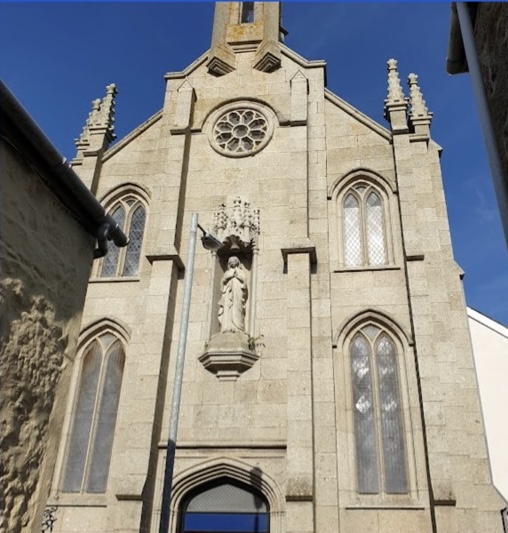
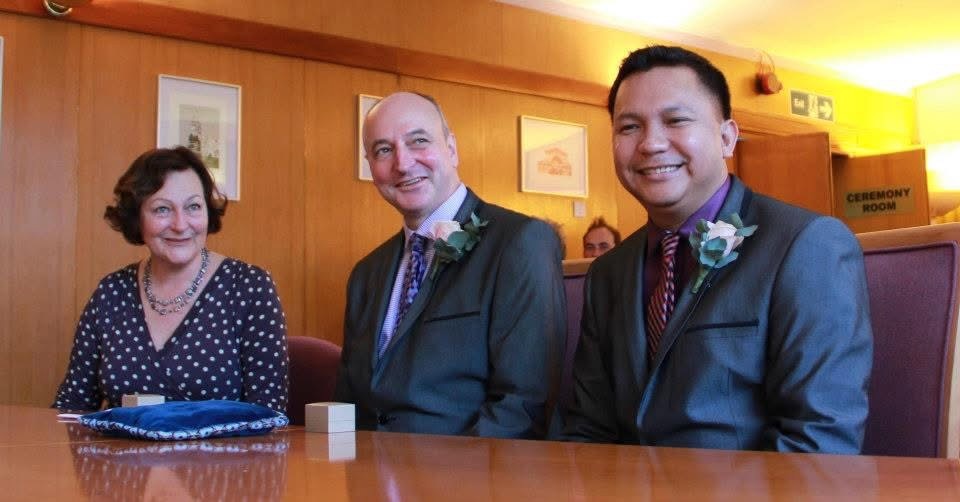

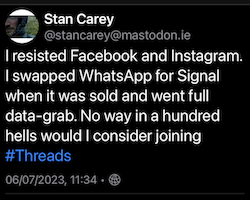

![Tweet: 'hang on honey i just need to check my account on Twitter, Mastodon, [etc etc]'.](https://occamstypewriter.org/trading-knowledge/files/2024/09/Hang-on-honey-I-just-need-to-check-my-account-on-Twitter-Bluesky.jpg)
